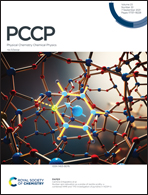Experimental and computational characterization of phase transitions in CsB3H8†
Abstract
Metal hydroborates are versatile materials with interesting properties related to energy storage and cation conductivity. The hydrides containing B3H8− (triborane, or octahydrotriborate) ions have been at the center of attention for some time as reversible intermediates in the decomposition of BH4− (3BH4− ↔ B3H8− + 2H2), and as conducting media in electrolytes based on boron-hydride cage clusters. We report here the first observation of two phase transitions in CsB3H8 prior to its decomposition above 230 °C. The previously reported orthorhombic room temperature phase (here named α-CsB3H8) with the space group Ama2 changes into a new phase with the space group Pnma at 73 °C (here named β-CsB3H8), and then into a face-centered cubic phase, here named γ-CsB3H8, at 88 °C. These phases are not stable at room temperature thus requiring in situ measurements for their characterization. The phase transitions and decomposition pathway of CsB3H8 were studied with in situ synchrotron powder X-ray diffraction (SR-PXD), in situ and ex situ vibrational spectroscopies (Raman and FTIR), and differential-scanning calorimetry combined with thermo-gravimetric analysis (DSC–TGA). The structure determination was validated by vibrational spectroscopy analysis and modeling of the periodic structures by density functional methods. In γ-CsB3H8, a significant disorder in B3H8− positions and orientations was found which can potentially benefit cation conducting properties through the paddle mechanism.

- This article is part of the themed collection: 2021 PCCP HOT Articles


 Please wait while we load your content...
Please wait while we load your content...